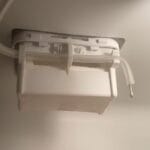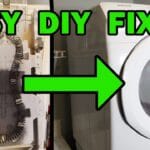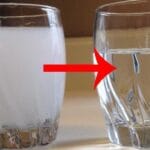Have you ever opened your kitchen cabinet, only to discover unsightly cracks marring its surface? It’s frustrating, isn’t it?
Your cabinets are more than just storage spaces; they’re a vital part of your home’s aesthetic. When they start to crack, it can feel like your entire kitchen is crumbling. You might be asking yourself, “Why are my cabinets cracking?
” And wondering if there’s a deeper problem at play. Well, you’re not alone. Many homeowners face this issue, and understanding the reasons behind it can save you time, money, and a lot of stress. Dive into the rest of this article to uncover the common causes of cabinet cracking, and learn how to prevent and fix these issues to keep your kitchen looking pristine. Your cabinets deserve to shine, and with a little insight, you can ensure they do just that.
Material Quality Issues
Cracking cabinets can be a frustrating issue that disrupts the aesthetics and functionality of your kitchen. One major culprit behind this problem is the quality of the materials used in the construction of your cabinets. Understanding the nuances of material quality can help you pinpoint why your cabinets are cracking and guide you towards solutions. Let’s dive into some specific factors related to material quality.
Low-grade Wood
One of the primary reasons your cabinets might be cracking is the use of low-grade wood. Cabinets crafted from inferior wood are more prone to warping and cracking over time. You might have noticed splinters or uneven surfaces on your cabinet doors.
Low-grade wood lacks the strength and durability needed to withstand changes in humidity and temperature. This can lead to unpleasant surprises like cracks appearing out of nowhere. Consider if your cabinets were made from wood such as particleboard or MDF (Medium Density Fiberboard). These materials are cheaper, but they don’t hold up well in the long run.
Have you ever had a piece of furniture made from low-grade wood that chipped easily? The same principle applies to cabinets. Investing in high-quality wood, like solid oak or maple, can save you from future headaches.
Inadequate Manufacturing Processes
The way your cabinets were manufactured plays a significant role in their durability. Poor craftsmanship can lead to weak joints and uneven surfaces, which can contribute to cracking. Imagine assembling a puzzle with pieces that don’t quite fit—eventually, stress points form, leading to damage.
Manufacturers who cut corners during production often skip crucial steps such as proper drying and finishing. Have you ever noticed that some cabinets feel flimsy or poorly assembled? This is a telltale sign of inadequate manufacturing processes.
As a homeowner, you should consider asking about the manufacturing processes when purchasing cabinets. It’s similar to buying a car—knowing the ins and outs of how it’s built can give you peace of mind about its longevity.
Before you decide on your next cabinet purchase, ask yourself: Are you willing to compromise quality for cost? Or would you rather invest in materials and manufacturing processes that ensure your cabinets stand the test of time?
Environmental Factors
Cracking cabinets can be a frustrating eyesore in your home. While there are several reasons why this might happen, environmental factors play a significant role. These factors can silently affect the integrity of your cabinets, leading to unsightly cracks. Understanding these elements can help you prevent damage and keep your cabinets looking pristine.
Humidity And Temperature Changes
Have you noticed your cabinets developing cracks during seasonal transitions? Variations in humidity and temperature can cause wood to expand and contract. This constant movement strains the material, leading to cracks over time.
Imagine the shock your cabinets experience when going from a humid summer to a dry winter. If your home lacks consistent climate control, this rapid change can be the culprit. Think about investing in a humidifier or dehumidifier to stabilize indoor conditions.
Sunlight Exposure
Ever admired how sunlight brightens your kitchen? While natural light is lovely, prolonged exposure can be harmful. Direct sunlight causes the wood to dry out, becoming brittle and prone to cracking.
Consider the placement of your cabinets. Are they next to a window? You might need to use blinds or UV-protective film on your windows. This small change can shield your cabinets from harsh rays and preserve their beauty.
Environmental factors, from humidity fluctuations to sunlight exposure, can subtly compromise your cabinets. By paying attention to these elements, you can save yourself from future headaches and maintain your cabinets’ appeal. What steps can you take to protect your cabinets today?
Improper Installation
Cabinets can crack due to improper installation. Correct installation ensures cabinet longevity. Many homeowners face issues after poor installation. Let’s explore common installation mistakes.
Incorrect Mounting Techniques
Incorrect mounting techniques can lead to cabinet cracks. Proper alignment is essential. Misalignment creates stress points. Stress points cause wood to split over time. Ensure all screws and nails are level. Level installation prevents unnecessary strain.
Installers sometimes rush the process. Fast work can mean inaccurate measurements. Inaccurate measurements result in a poor fit. A poor fit means more stress on the wood. Carefully measure each component for a snug fit.
Lack Of Support Structures
Cabinets need strong support structures. Weak supports lead to sagging. Sagging puts pressure on cabinet joints. Over time, this pressure causes cracks. Ensure ample support under each cabinet.
Support structures distribute weight evenly. Uneven weight distribution stresses the cabinet frame. Frames under stress will eventually crack. Use quality materials for added strength. Quality materials withstand daily use better.
Check for proper bracket installation. Brackets help stabilize the cabinet. Properly placed brackets minimize stress. Less stress means fewer cracks.
Wear And Tear
Cabinet cracking often results from daily wear and tear, including frequent use and exposure to moisture. Temperature changes can cause wood to expand and contract, leading to visible cracks. Over time, these factors weaken the cabinet structure, making cracks more likely.
Cabinets are an essential part of any home, providing both functionality and style. However, over time, you might notice that your cabinets start to crack. This is often due to wear and tear, a natural process that occurs as your cabinets endure daily use. Understanding the factors that contribute to this wear and tear can help you prevent further damage and extend the life of your cabinets.
Frequent Use And Pressure
Every time you open and close a cabinet door, you’re putting pressure on the hinges and joints. Imagine the force exerted over years of use. If your family is like mine, where everyone seems to be in and out of the kitchen constantly, those hinges are in near-constant motion. This frequent use can cause the wood or material to weaken, leading to small cracks over time. Additionally, if your cabinets are used to store heavy items like pots and pans, the constant weight can increase the pressure on shelves and joints. You might want to consider redistributing heavier items or using additional supports. Are the items you store in your cabinets putting too much strain on them?
Neglect In Maintenance
Regular maintenance is key to preventing cabinet wear and tear. It’s easy to overlook cleaning and checking your cabinets for signs of damage. However, neglecting these small tasks can lead to bigger issues like cracking. When was the last time you checked your cabinet hinges or cleaned the surfaces? Dust and grime can accumulate, affecting the cabinet material. A simple routine of wiping down your cabinets and checking for any loose screws can make a significant difference. By addressing these maintenance tasks regularly, you can save yourself from expensive repairs down the line. Are you giving your cabinets the care they deserve?
Impact Of Household Activities
Household activities can significantly impact the longevity of your cabinets. Everyday tasks might seem harmless, but they can lead to cracks over time. Understanding these effects can help preserve your cabinets and save on repairs.
Water Spills And Leaks
Water is a cabinet’s worst enemy. Spills and leaks can seep into the wood. This causes swelling and warping. Left unchecked, moisture can weaken the cabinet structure. Always clean spills immediately and check for leaks regularly.
Cooking Heat And Steam
Cooking generates heat and steam. These can stress your cabinets. Over time, this exposure can lead to cracking. Use exhaust fans to reduce steam buildup. Let your cabinets cool before touching them.

Credit: www.reddit.com
Signs Of Structural Damage
Cabinets show signs of wear over time. Recognizing these signs helps in early repair. Structural damage can cause cabinets to lose functionality and appeal.
Identifying the signs is crucial. Addressing them prevents further issues. Let’s explore the key indicators of structural damage.
Visible Cracks And Splits
Check for visible cracks or splits on cabinet surfaces. Cracks may appear on doors or frames. They often indicate underlying structural issues. Excessive moisture or temperature changes can cause these cracks.
Look closely at joints and seams. Splits may start small but grow over time. These splits weaken the cabinet structure. Early detection helps in preventing further damage.
Loose Hinges And Handles
Loose hinges are a common sign of cabinet damage. Check if doors hang unevenly. This might indicate loose hinges. Tighten them to prevent further loosening.
Handles also become loose over time. This makes opening cabinets difficult. Loose handles can damage the wood if not fixed. Regularly check and tighten them to maintain cabinet integrity.
Preventive Measures
Cabinets may crack due to humidity changes and poor construction. Ensure proper ventilation and quality materials for prevention. Regular maintenance helps in avoiding cracks and prolongs cabinet life.
Cracking cabinets can be an irritating issue, especially when you’ve invested time and money to make your kitchen or bathroom look perfect. The good news is, you can take several preventive measures to keep your cabinets looking pristine and crack-free. By focusing on regular maintenance and choosing durable materials, you can ensure your cabinets remain in excellent condition for years.
Regular Maintenance
Regular maintenance is your best friend when it comes to preventing cabinet cracks. Simple actions like cleaning your cabinets with a soft, damp cloth can do wonders. Avoid using harsh chemicals that can weaken the wood over time. Inspecting your cabinets periodically can help you catch small problems before they become big ones. Tighten loose screws and hinges, as they can cause undue stress on the cabinet structure. If you find any small cracks, fill them immediately to prevent further damage. Have you ever noticed how a well-oiled machine works smoothly? The same applies to your cabinets. Use lubricants on the hinges to ensure they open and close without any strain. Proper ventilation in your kitchen or bathroom also helps in reducing moisture buildup, which can cause wood to swell and crack.
Choosing Durable Materials
Choosing the right materials can make all the difference in preventing cabinet cracks. Opt for high-quality hardwoods like oak or maple, which are known for their strength and durability. These materials are less likely to warp or crack over time. Have you ever tried using particleboard for cabinets? If so, you might have noticed that it doesn’t hold up as well as solid wood. It’s worth investing a bit more upfront for materials that will last longer and save you headaches down the road. Consider finishes that protect against moisture and heat. A good finish acts like a shield, preventing water from seeping into the wood. This is especially important in areas prone to humidity, like kitchens and bathrooms. By focusing on these preventive measures, you’re not just protecting your cabinets, but also your investment. What small changes can you make today to keep your cabinets in top shape?

Credit: www.reddit.com

Credit: www.reddit.com
Frequently Asked Questions
Why Are My Cabinets Developing Cracks?
Cabinet cracks often result from humidity changes. Wood expands and contracts. Poor installation can also cause cracking.
How Can Humidity Affect My Cabinets?
High humidity can make wood swell. Low humidity can cause it to shrink. Both lead to cracks.
What Materials Are Prone To Cracking?
Solid wood is most susceptible. MDF and plywood are more stable. They resist temperature and humidity changes.
How Can I Prevent Cabinet Cracking?
Maintain a stable indoor climate. Use dehumidifiers or humidifiers. Ensure proper installation and regular maintenance.
Can I Repair Cracked Cabinets Myself?
Small cracks can be filled. Use wood fillers or putty. For large cracks, professional help is recommended.
Conclusion
Cracking cabinets can be a real headache. Causes include humidity and poor installation. Regular checks help prevent damage. Using quality materials ensures long-lasting cabinets. Avoid excess moisture and sunlight exposure. Proper cleaning and maintenance are essential. Consider consulting experts for persistent issues.
Upgrading hardware can also help. Keep an eye on temperature changes. Small fixes now save big repairs later. Don’t ignore minor issues. Take action early to protect your investment. Happy cabinets mean a happy home. Remember, prevention is better than cure.
Stay vigilant and enjoy flawless cabinets for years.




